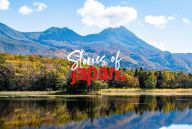
View from Amami-Oshima Island, part of a collective of islands in Kagoshima and Okinawa Prefecture recently named a UNESCO World Heritage Site – Image provided courtesy of Kagoshima Prefectural Government
With the Tokyo 2020 Games now behind us and the medal counting over, it’s a good time to reflect on the things we’ve learned about the hosting nation, and Japan’s respect and drive for sustainability would probably be top of the list.
As the world’s top athletes descended on the Tokyo Olympic village, revelations of cardboard beds caused a media frenzy, but it quickly shone a spotlight on the Games’ commitment to environmental issues. In fact, the Tokyo 2020 Olympics and Paralympics set out five themes and goals on sustainability including “Towards Zero Carbon”, “Zero Wasting”, “Nature Within the City”, “Celebrating Diversity”, and “Equality”.
With sustainability top of mind, what many people probably still don’t know is that as well as beds made from cardboard, this year’s Olympic medals were made from used smartphones, torchbearer uniforms were fashioned with recycled Coca-Cola bottles, the hydrogen fuelled torch was partly made using aluminium from disaster relief shelters used in the 2011 Great East Japan Earthquake, and even the medal podiums had been 3D printed from household plastic waste.
We might not have been able to travel to the Tokyo Games this year, but Japan’s determination to preserve the environment is something visitors to Japan can feel and experience at any time. Just last month, UNESCO announced that it was adding two more UNESCO World Heritage Sites in Japan including several islands spanning Kagoshima and Okinawa Prefectures and the cultural Jomon Prehistoric Sites in Hokkaido, Northern Japan.
Japan’s must-see natural UNESCO World Heritage Sites
Japan is now home to a total of 25 UNESCO sites comprising 20 cultural sites and 5 of natural significance. Protection, management, authenticity, and integrity of properties are some of the most important considerations when officially adding UNESCO sites to the list. Here’s a roundup of Japan’s most well-preserved and environmentally significant World Heritage Sites:
Amami-Oshima Island, Tokunoshima Island, Northern part of Okinawa Island, and Iriomote Island – Kagoshima and Okinawa Prefectures
Recently added to the list of natural World Heritage Sites and the home of several endemic species, some of which are now globally threatened, the islands are recognised for their importance for biodiversity conservation. Living among the 42,698 hectares of subtropical laurel forests and primitive vegetation, the islands’ rare endangered species include the Amami rabbit, Iriomote cat, and the Okinawa rail (species of bird). Many other endemic plants, mammals, birds, reptiles, amphibians, inland water fish, and decapod crustaceans also make up the islands’ unique biodiversity. Crucially, the people of the islands are known for their close relationship with nature and dedication to preserving and making the islands more attractive.
Ogasawara Islands
Made up of 30 volcanic islands, the remote subtropical Ogasawara Islands are located 1000km south of Tokyo and are visited for their dramatic scenery, pristine beaches, lively coral reefs, and rainforest covered hills. So far away from the mainland, it’s no surprise that it’s abundance of flora and fauna include many plants and animals that can only be found on the islands. The rare Bonin Flying Fox, 195 species of bird, and 441 native plants have all been identified as unique to the islands. Accessible by ferry from Tokyo, only the largest islands are inhabited, Chichijima and Hahajima.
Shirakami-Sanchi, Tohoku
Covering a third of Shirakami mountain range in the Tohoku region of northern Honshu, the Shirakami-Sanchi World Heritage Property includes the largest remaining virgin beech forest in East Asia. The cool-temperate beech forests covering the slopes once sprawled across most of northern Japan and are said to be eight to twelve thousand years old. 87 Species of bird, the black bear, and serow (goat-like mammal) all live in the last remaining 17,000 hectares of these endangered beech forests.
Shiretoko, Hokkaido
The Shiretoko Peninsula is a cape located on the northeast of Hokkaido, Japan’s northern-most island. Extending into the Sea of Okhotsk, the Shiretoko site is recognised for its unique interaction between terrestrial and marine ecosystems. With roads only extending along three-quarters of the peninsula, the northernmost tips can be explored by sightseeing boats or trekking tours. Many endangered and endemic animal and plant species live on the peninsula including the brown bear, dear, and foxes.
Yakushima, Kagoshima
On the subtropical mountainous Yakushima Island, the Yakushima World Heritage Site is a primeval temperate rainforest situated in the centre of the island which branches out to the coast. The rainforest is home to incredibly large cedar trees thousands of years old and is recognised as one of the last ecosystems dominated by Japanese cedar. The area has become popular with hikers who walk the trails to marvel at these gigantic trees.
Japan’s unique museum culture shines light on sustainability and the environment
In a country that has always had an adoration for unique and informative museums relating to various human interests, such as Japan’s many quirky food museums, there are also several dedicated to educating people about the environment and sustainability. Visiting any of these could offer some fresh and unexpected perspectives on your trip to Japan, especially given the recent report into climate change by the UN's Intergovernmental Panel on Climate Change (IPCC). These include:
The National Museum of Emerging Science and Innovation, Tokyo
Here, visitors can come to understand more about the issues affecting human life on Earth and what they can do to change the world for the better. Aside from becoming enlightened about environmental issues and how to make better choices for the future, you can also find out about the potential role of robots in future society and learn about the futuristic concept of ‘digital nature’.
National Museum of Nature and Science, Tokyo
As one of Japan’s biggest science museums with more than 25,000 exhibits, the National Museum of Nature and Science covers anything from environmental issues to robots. Some of the most noteworthy museum exhibits will take you on a journey through Japan’s unique ecosystems to the latest advances in tech.
Museum of Nature and Human Activities, Hyogo
The Museum of Nature and Human activities aims to help people understand and appreciate the beauty and significance of the natural environment around them. Home to an extensive and unique collection of biological and geological specimens, visitors can learn more about nature and its interaction with human life.
Kitakyushu Environment Museum, Fukuoka
With Kitakyushu having historically suffered with pollution issues, the museum serves as a reminder of the value of supporting the environment and how the city came to reclaim its clear blue skies and sea. The museum showcases some of the environmental technologies used in the city today, which is now known for its progressive environmental initiatives and eco-friendly way of life.
Eco-museums
Japan’s sparsely populated and more rural Hokkaido region is home to the country’s unique ‘eco-museum’ concept in its sprawling National Parks including Akankohan Eco-Museum Center, and Kawayu Eco-museum Center. Both museums are specially set up to connect visitors with their surrounding environment through sensory experiences and education around local nature, history, and culture.

For more information, please contact:
James Cooley | james.cooley@standoutcontent.com.au | +61 401 316 701



















































